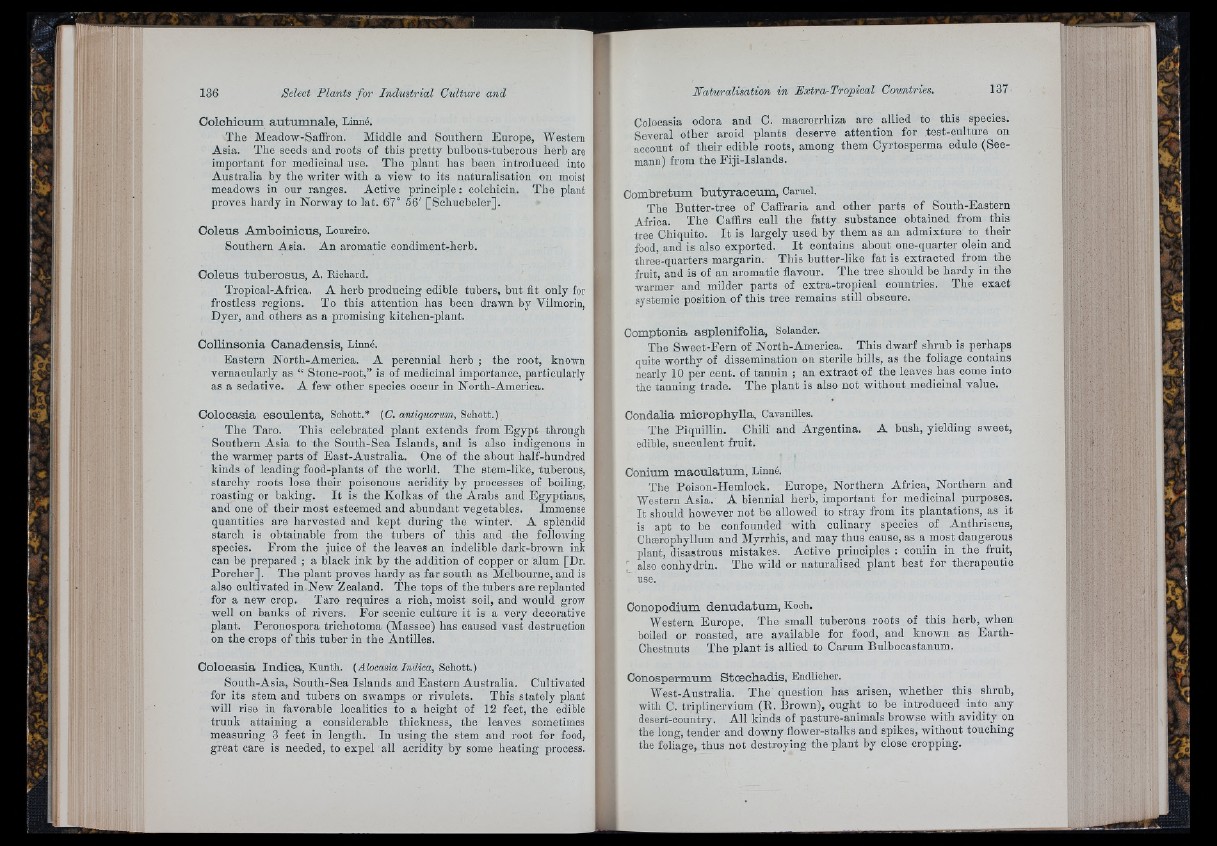
C o lc h io um a u tum n a l© , Linné.
The Meadow-Saffron. Middle and Southern Europe, Western
Asia. The seeds and roots of this pretty bulbous-tuberous herb are
important for medicinal use. The plant has been introduced into
Australia by tlie writer with a view to its naturalisation on moist
meadows in our ranges. Active principle: colcliiciu. The plant
proves hardy in Norway to lat. 67° 56' [Schuebeler].
C o le u s A m b o in ic u s , Loureiro.
Southern Asia. An aromatic condiment-herb.
C o le u s tu b e r o s u s , A. Richard.
Tropical-Africa. A herb producing edible tubers, but fit only for
frostless regions. To this attention has been drawn by Vilmorin,
Dyer, and others as a promising kitohen-plant.
C oU in so n ia C a n a d e n s is , Linné.
Eastern North-America. A perennial herb ; the root, known
vernacularly as “ Stone-root,” is of medicinal importance, partioularly
as a sedative. A few other species occur in North-America.
C o lo c a s ia e s c u le n ta , Schott.* (C. antiquorum, Schott.)
The Taro. This celebrated plant extends from Egypt through
Southern Asia to the South-Sea Islands, and is also indigenous in
the warmer parts of East-Australia. One of the about half-hundred
kinds of leading food-plants of the world. The stem-like, tuberous,
starchy roots lose their poisonous acridity by processes of boiling,
roasting or baking. I t is the Kolkas of the Arabs and Egyptians,
and one of their most esteemed and abundant vegetables. Immense
quantities are harvested and kept during the winter. A splendid
starch is obtainable from tlie tubers of this and the following
species. From the juice of the leaves an indelible dark-brown ink
can be prepared ; a black ink by the addition of copper or alum [Dr.
Porcher]. The plant proves hardy as far south as Melbourne, and is
also cultivated in New Zealand. 'The tops of the tubers are replanted
for a new crop. 'Taro requires a rich, moist soil, and would grow
well on banks of rivers. For scenic culture it is a very decorative
plant. Peronospora trichotoma (Masses) has caused vast destruction
on the crops of this tuber in the Antilles.
C o lo c a s ia In d ic a , Kunth. (Alocasia Indica, Schott.)
South-Asia, South-Sea Islands and Eastern Australia. Cultivated
for its stem and tubers on swamps or rivulets. This stately plant
will rise iu favorable localities to a height of 12 feet, the edible
trunk attaining a considerable thickness, the leaves sometimes
measuring 3 feet in length. In using the stem aud root for food,
great care is needed, to expel all acridity by some heating process.
Colocasia odora and C. macrorrhiza are allied to this species.
Several other aroid plants deserve attention for test-culture on
account of their edible roots, among them Cyrtosperma edule (Seemann)
from the Fiji-Islands.
C om b r e tum b u t y r a c e u m , Caruel.
The Butter-tree of Caffraria and other parts of South-Eastern
Africa. The Caffirs call the fatty substance obtained from this
tree Chiquito. I t is largely used by them as an admixture to their
food, and is also exported. I t contains about one-quarter olein and
three-quarters margarin. This butter-like fat is extracted from the
fruit, and is of an aromatic flavour. The tree should be hardy in the
warmer and milder parts of extra-tropical countries. The exact
systemic position o f this tree remains still obscure.
C om p to n ia a s p le n ifo lia , Solander.
The Sweet-Fern of North-America. This dwarf shrub is perhaps
quite worthy of dissemination on sterile hills, as the foliage contains
nearly 10 per cent, of tannin ; an extract of the leaves has come into
the tanning trade. The plant is also not without medicinal value.
C o n d a lia m ic r o p h y lla , Cavanilles.
The Piquillin. Chili and Argentina. A hush, yielding sweet,
edible, succulent fruit.
C o n ium m a c u l a t u m , Linné.
The Poison-Hemlock. Europe, Northern Africa, Northern and
Western Asia. A biennial herb, important for medicinal purposes.
It should however not be allowed to stray from its plantations, as it
is apt to be confounded with culinary species of Anthriscus,
Chærophyllum and Myrrhis, and may thus cause, as a most dangerous
plant, disastrous mistakes. Active principles : coniin iu the frub,
;■ also oonhydrin. The wild or naturalised plant best for therapeutic
C o n o p o d ium d e n u d a t u m , Koch.
Western Europe. The small tuberous roots of this herb, when
boiled or roasted, are available for food, and known as Earth-
Chestnuts The plant is allied to Carum Bulbocastanum.
C o n o sp e rm um S tm c b a d is , Endlicher.
West-Australia. The question has arisen, whether this shrub,
with C. triplinervium (R. Brown), ought to be introduced into any
desert-country. All kinds of pasture-animals browse with avidity^ on
the long, tender and downy flower-stalks and spikes, without touohing
the foliage, thus not destroying the plant by close cropping.